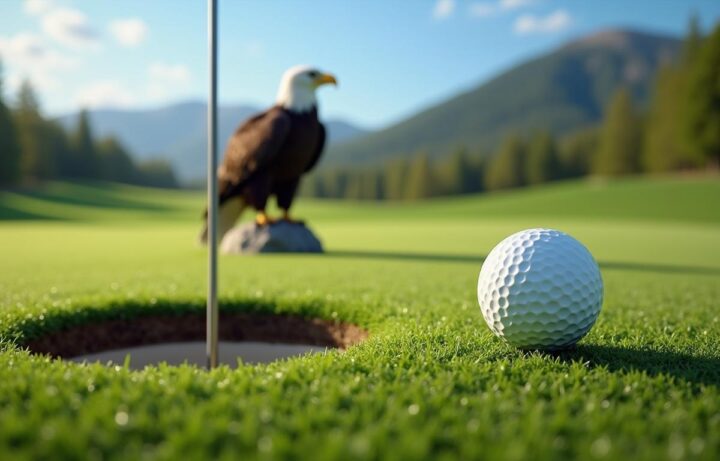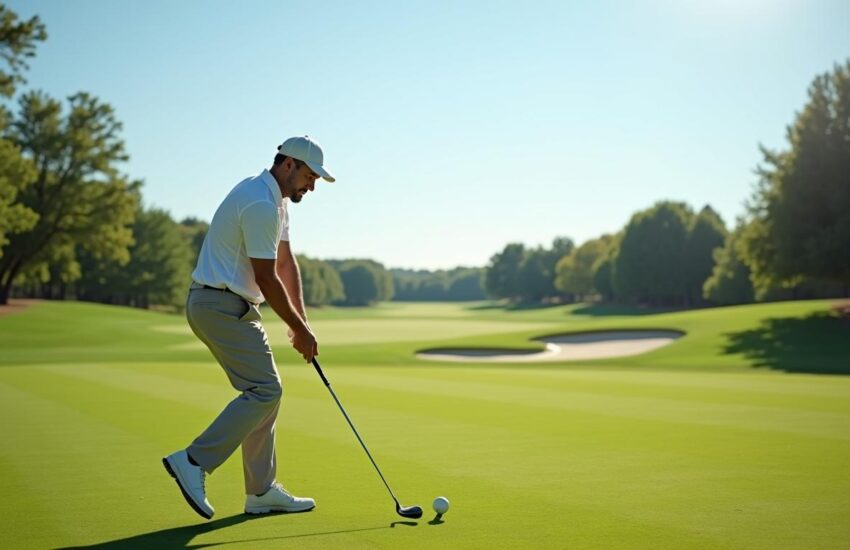What is an Eagle in Golf?
What is an eagle in golf? An eagle in golf happens when a player scores two strokes under par on a hole. New players usually focus on hitting straight shots, but experienced golfers aim for these special scoring chances. Eagles rarely happen, even among pro players.
The eagle builds on the more common “birdie” score of one under par. Pro golfer Sungjae Im scored just 18 eagles in 2,124 holes during 2019—only 0.85% of his total holes. Martin Laird did a bit better with 17 eagles in 1,440 holes, reaching about 1.18%. Regular golfers with handicaps between 16 and 20 average only 0.3 birdies per round, which makes eagles much harder to achieve.

Players score eagles most often on par 5 holes by reaching the green with two strong shots. The eagle sits between a birdie and the rare albatross (three under par, also known as a double eagle) in golf’s scoring system. This piece covers all the basics about eagles and other key scoring terms that new golfers should know.
What is an Eagle in Golf?
The scoring system in golf can puzzle newcomers to the sport. My trips to golf courses worldwide have shown me that beginners often ask what is an eagle in golf and how it fits into scoring. Let me share what I’ve learned from playing courses from Scotland to Thailand.
Definition and Scoring Breakdown of What is an Eagle in Golf
A golf eagle means scoring exactly two strokes under par on any hole. Players record this amazing feat as “-2” on their scorecard. You’ll need to understand par first to really get what is an eagle in golf.
Par shows how many strokes a skilled golfer should take to finish a hole. Every hole gets a par rating—usually 3, 4, or 5—based on its length and challenge level. You might see a par-6 hole too, but these are very rare.
Eagles sit right between birdies (one stroke under par) and albatrosses (three strokes under par, also called a double eagle) in golf scoring. The rarest of all is the condor or triple eagle—scoring four strokes under par.
In golf what is an eagle shows a moment of pure excellence with perfect shot-making and smart strategy. I’ve played hundreds of rounds across different continents, and nothing beats the rush of scoring an eagle.
Examples of Eagle Scores on Different Holes
What is an eagle in golf terms changes based on the hole’s par:
- Par-3 hole: An eagle means a hole-in-one or “ace”
- Par-4 hole: You need just two strokes for an eagle
- Par-5 hole: Three strokes will get you an eagle
- Par-6 hole: Four strokes earn you an eagle
Most eagles happen on par-5 holes and odds are it’s golfers breaking 80. Big hitters can reach the green in two shots and sink the putt. This mix of power and accuracy explains why par-5s produce more eagles in tournaments.
Getting an eagle on a par-4 means either driving to the green and making one putt or holing your shot from the fairway. Both take great skill and some luck—something I’ve seen while playing with pros in pro-ams.
Eagles on par-3s are possible but golfers just call them holes-in-one or aces. These amazing shots need perfect distance control, accuracy, and sometimes a lucky bounce.
No matter the hole, what is an eagle in golf comes down to great shots and a bit of good luck. Eagles don’t happen often, which makes them special.
I’ve managed just a few eagles in my games across five continents—mostly on shorter par-5s with helpful slopes. I’m still chasing what is an albatross in golf, as I haven’t seen one yet, even playing with pros with average golf handicap scores than me.
Eagles are much rarer than a par or even a birdie. They’re definitely more special than a bogey—though many casual players focus on whether is bogey golf good enough for their level before dreaming about eagles.
How the Term ‘Eagle’ Came to be
Golf terminology has fascinating origins that I discovered while playing historic courses. Let me tell you about what is an eagle in golf by first looking at how its predecessor—the birdie—came to be.
The Origin of Birdie and Its Influence
The term “birdie” showed up in American golf circles as the 20th century began. Back then, “bird” was American slang that meant something really wonderful. We can trace this term’s birthplace to Atlantic City Country Club in New Jersey.
H.B. Martin’s “Fifty Years of American Golf” tells us about a key moment in 1899. Golfer Ab Smith hit a shot that landed inches from the cup. “That was a bird of a shot,” Smith said, suggesting his playing partners should pay “double compensation”. The group started using “birdie” right away for holes finished one stroke under par.
The term made its way across the Atlantic Ocean to England by 1913 and became part of golf’s international vocabulary.
Why ‘Eagle’ was the Next Logical Step
The story of what is an eagle in golf naturally grew from the birdie concept. After golfers named one under par a “birdie,” they needed a word for the even better achievement of scoring two under par.
The bird theme made perfect sense—a common bird stood for one under par, so something more magnificent would represent an even better score. What is an eagle in golf terms became obvious: it stood for something beyond a regular birdie.
What is an eagle in golf emerged through this natural progression. Eagles are bigger, more majestic, and more powerful than smaller birds, just like scoring two under par showed greater skill than a birdie.
The pattern continued with “albatross” (or double eagle) for three under par, and the rare “condor” for four under par, keeping the bird hierarchy intact. If you’re curious about what is an albatross in golf, that’s a story for another time!
American Roots of the Term
In golf what is an eagle comes straight from American origins, just like birdie. Eagles made perfect sense as America’s national symbol.
The eagle term followed shortly after birdie became popular, though we don’t know the exact year like we do with birdie’s 1899/1903 origins. What is an eagle in golf became a standard part of American golf language before spreading worldwide.
British golfers first heard this American terminology in 1919. H.D. Gaunt shared stories about the “birdie” and “eagle” terms he learned during his Canadian travels.
British publications labeled eagle as American terminology for years afterward. Cecil Leitch, the famous golfer, described a putt for 3 on a par-5 hole as “securing what is known in American golfing parlance as an ‘eagle'” in 1922.
These regional differences in terminology catch my attention when I play courses around the world. Whether you’re aiming for par, trying to avoid a bogey, or working out your golf handicap, these scoring terms bring golfers together globally. Now you can share the rich American history when someone asks “what is an eagle in golf,” along with explaining why is bogey golf good enough for casual players—but that’s a topic for another day!

When and Where Eagles Happen Most
Eagles capture golfers’ imagination at every level. My global golfing adventures have shown me patterns in what is an eagle in golf chances on courses of all types. The wind-swept links of Scotland and tropical Hawaiian layouts share common features that create better chances to score these elusive two-under-par shots.
Par 5 Holes and Reachable Greens – Where to Find What is an Eagle in Golf
Par 5 holes produce the most eagles. This makes sense from a strategy standpoint. Players with power have a big advantage on these longer holes. They can reach greens in just two solid shots and set up eagle putts. My round at Royal Liverpool showed me how the 5th and 16th holes were eagle magnets during championship play. These par 5s yielded 23 and 27 eagles at the 2006 Open Championship.
Players usually score eagles with a simple formula: bomb a drive, place the second shot on the green, and make the putt. Professional tournaments prove this pattern. The 2015 Masters saw eagles bunch up on four holes: the 2nd, 8th, 13th and 15th – all par 5s players could reach in two shots.
Course Design and Layout Factors
Course architecture shapes what is an eagle in golf terms by creating scoring chances. Designers think over risk-reward scenarios that tempt players into aggressive eagle plays. Course layout plays a huge role in eagle opportunities. Some courses offer strategic chances on par 5s, while others make two-under-par nearly impossible on certain holes.
Smart architects place hazards, narrow landing areas, and design green complexes that test player decisions. Eagles often come down to weighing risk against reward. Shorter par 4s between 280-350 yards give players another shot at eagles. These holes usually have well-guarded greens with bunkers or water protecting the front.
How Tee Placement Affects Eagle Chances
Tee box position can make or break what is an eagle in golf possibilities. Strategic tee placement might create or eliminate eagle opportunities. Good players know their dispersion rates must match the landing area. Pros typically see 50-60 yard dispersion with drivers.
Players need to adapt their strategy based on tee locations. The smart play sometimes means less club off the tee to improve eagle chances by staying out of trouble. One pro told me he scores more eagles by hitting 4-iron instead of driver on certain par 5 tees. This sets up perfect angles for aggressive second shots.
The chase for eagles means each hole needs a unique approach. This hits home as I track my moments (still waiting for my first). Whether you calculate your , hope for a , play for , or avoid a , knowing where eagles happen most helps your course strategy. And yes, enough for most amateurs? You bet – but eagles bring the real excitement!
How Rare is an Eagle in Golf Terms?
Many golfers chase their first eagle for years. During my time playing golf around the world, I’ve found exactly what is an eagle in golf and how rare these achievements really are. Let’s tuck into the numbers that show why they don’t happen often.
Eagle Stats from Pro Tours
Scoring what is an eagle in golf doesn’t happen much, even for professionals. PGA Tour stats show players average just 2 eagles through the PGA Championship in 2022. Top performers like Ryan Gerard and Alejandro Tosti managed to record 12 eagles during this time. Justin Thomas leads with 136 eagles in 241 events. These numbers show how tough it is to score eagles regularly.
Chances for Amateur Golfers
Regular players wondering what is an eagle in golf terms face even tougher odds. A typical golfer scores an eagle once every 100 rounds. This means you might see an eagle once every two years. The rare nature of eagles makes them exciting to witness at courses worldwide. More than that, I’ve noticed golf eagles vary a lot based on player skill and how hard the course is.
What Makes Eagles so Difficult
Scoring what is an eagle in golf is tough for several reasons. We see eagles most often on par-5 holes, where players can reach the green in two strong shots. Par-4 eagles happen by a lot less often because they need exceptional driving distance and accuracy. An eagle on a par-3 means hitting a hole-in-one—one of golf’s most celebrated achievements.
I’ve played on five continents and scored just three eagles. Each one stays fresh in my memory and pushes me to calculate my next . Eagles need both skill and luck, unlike a simple or even a . That’s why I tell my readers not to worry about —most amateurs should be happy with a instead of chasing eagles or .

Tips to Improve Your Chances of Scoring an Eagle
My golf adventures around the world have taught me practical ways to boost your chances of scoring eagles. Learning what is an eagle in golf starts you off, but scoring one needs skill, strategy, and sometimes luck.
Mastering Long Drives and Second Shots
Your path to scoring what is an eagle in golf starts with powerful, accurate drives. A smooth yet powerful swing comes from regular practice of your technique. Your grip, stance, and follow-through need special attention. Second shots become just as vital – especially on par-5 holes where you can reach the green in two strokes for eagle putts.
Course Management and Club Selection
Smart decisions shape your eagle opportunities in golf. The right club choice significantly affects your chances:
- Drivers give you maximum distance for tee shots on par-5s
- Fairway woods and hybrids work best for long second shots
- Precise irons let you control approach shots
- A reliable putter helps convert eagle opportunities
Smart course management means studying layouts beforehand, spotting hazards, and planning your shots strategically. Sometimes a 3-iron off the tee instead of a driver puts you in better position for aggressive second shots.
Playing from the Right Tees
What is an eagle in golf terms becomes easier when you play from suitable tees. The PGA of America suggests picking tees based on your driving distance:
- 275-yard drives: 6,700-6,900 yard courses
- 250-yard drives: 6,200-6,400 yard courses
- 225-yard drives: 5,800-6,000 yard courses
The quickest way to find your ideal course yardage is to multiply your average 5-iron distance by 36. Playing from proper tees lets you hit various clubs on approach shots, creating more eagle opportunities.
Tracking Your Progress with a Golf Handicap
Your works as a tool for improvement. It helps identify strengths and weaknesses, so you can practice specifically to improve your eagle chances. A decreasing handicap shows progress toward the skill level where scoring, or avoiding happens more often.
Understanding or relates to this progression—these rare scoring achievements become more possible as your skills improve through focused practice.
What is an Eagle in Golf Frequently Asked Question
What exactly is an Eagle in Golf?
An eagle in golf is when a player scores two strokes under par on a single hole. For example, completing a par-5 hole in just 3 strokes would be an eagle.
How Common are Eagles in Golf?
Eagles are relatively rare in golf. Professional golfers on the PGA Tour average only about 2 eagles per tournament. For amateur golfers, scoring an eagle might happen only once every 100 rounds or so.
What’s the Difference between an Eagle and a Hole-in-one?
An eagle is any score that’s two under par for a hole, while a hole-in-one specifically refers to scoring an eagle on a par-3 hole by sinking the ball in one shot from the tee.
On which Type of Holes are Eagles most likely to Occur?
Eagles most frequently happen on par-5 holes, where skilled golfers can potentially reach the green in two powerful shots, setting up an opportunity for a one-putt eagle.
How can I Improve My Chances of Scoring an Eagle?
To increase your eagle opportunities, focus on improving your long drives and second shots, practice smart course management, play from appropriate tees for your skill level, and track your progress using a golf handicap system.
What is the Origin of the Term “Eagle” in Golf?
The term “eagle” originated in the early 1900s as a natural progression from the term “birdie,” which means one stroke under par. Since an eagle is a larger and more impressive bird, it symbolized an even better score.
Can Beginners Realistically Score an Eagle?
While possible, it’s uncommon for beginners to score an eagle due to the precision and distance required. Most eagles are achieved by experienced players who can consistently hit long and accurate shots.
Do Eagles Count Toward Your Handicap?
Yes, eagles are factored into your golf handicap. Making an eagle will lower your handicap index over time, reflecting your improved performance relative to par.
What Clubs are Typically Used to Make an Eagle?
Eagles usually involve a powerful drive with a driver, followed by a strong fairway wood or long iron shot that reaches or approaches the green, and then a successful putt.
Are There Famous Eagles in Professional Golf History?
Yes, several iconic eagles have occurred in professional golf, such as Gene Sarazen’s double eagle at the 1935 Masters and Phil Mickelson’s eagle on the 13th hole during his 2010 Masters win, both pivotal moments in golf history.


